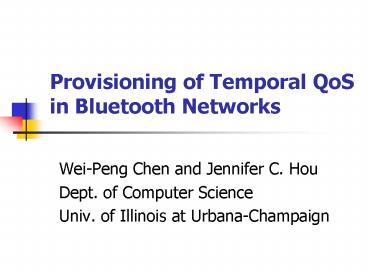Provisioning of Temporal QoS in Bluetooth Networks - PowerPoint PPT Presentation
1 / 21
Title:
Provisioning of Temporal QoS in Bluetooth Networks
Description:
Examples: {(1,5),(2,9)} {(1,4),(2,8)} Static Intra-Piconet Scheduling ... Deficit Round Robin (DRR), Adaptive Flow-based Polling (AFP), and Round Robin (RR) ... – PowerPoint PPT presentation
Number of Views:23
Avg rating:3.0/5.0
Title: Provisioning of Temporal QoS in Bluetooth Networks
1
Provisioning of Temporal QoS in Bluetooth Networks
- Wei-Peng Chen and Jennifer C. Hou
- Dept. of Computer Science
- Univ. of Illinois at Urbana-Champaign
2
Motivation
- Existing scheduling algorithms in Bluetooth
Systems focus on throughput, fairness but not QoS - Goals
- Fulfill temporal QoS requirements
- Compliance with the Bluetooth specification
- Handle dynamic establishment and termination of
connections - Based on distance-constrained task model
- Focus on intra-piconet scheduling in this paper
3
Review of Intra-Piconet Scheduling
- Schedule is controlled by the master on a TDM
basis. - A slave is allowed to send a packet only when it
is polled by the master. - The master transmits a packet to a slave in an
even slot and the slave sends back a packet to
the master in the subsequent odd slot.
4
QoS Signaling Mechanism
- quality of service msg is sent by a master to
notify a slave of the pending traffic - The slave must accept it in any case
- quality of service req msg is initiated by a
slave - can be accepted or rejected by the master.
- Parameters carried in msg specifying the QoS
characteristics of connections - Polling interval the max endurable spacing
between two consecutive polls for a Master-Slave
pair (MSP).
5
Message Model (Ci ,Di)
- Connection Mi is expressed as (Ci ,Di)
- Ci max amount of msgs (in slots) can be sent
from Mi within any period of Di - Di the deadline for the messages in Mi
- if Mi arrives at time t, it must be sent by time
tDi
6
Static Intra-Piconet Scheduling Problem
Definition
- Given a set of connections
, allocate slots to all msg. in Mi before its
deadline Di - Consider first
- static case connection set M is fixed
- uni-directional connection (either from master to
slaves or from slaves to the master)
7
Static Intra-Piconet Scheduling Step I
Specialization
- Transform given connection set M to M
- DD1,D2,,Dn consists solely of multiples
- Di ? Di (more restricted constraint)
- Specializing D(M) with respect to 2
- Examples (1,5),(2,9)? (1,4),(2,8)
8
Static Intra-Piconet Scheduling Step II
SlotAllocator
- SlotAllocator assigns the current slot to the
connection with the tightest deadline among all
connections have not fulfilled the requirements - Theorem 1 If Di divides Dj for all i lt j and
?(M) ? 1, SlotAllocator will allocate Ci slots to
Mi in any time window of size Di slots, for all
i. - Total utility
- Schedulability check
9
Dynamic Intra-Piconet Scheduling
- Extension to dynamic connection establishment and
termination - Only consider uni-directional connection
- Artificially add one null message stream ME
- Slots assigned to the null stream ME will be used
to transmit regular, non-QoS-sensitive messages.
10
Temporal Distance Constraint
- Decompose each Mi into a set of sub-connections,
s.t. - Ex (5,8) (1,2) (1,8)
- Schedule sub-connection Mij(1,Dij)
- Equivalent to two consecutive slots for Mij must
be less than Dij - ? Temporal distance constraint
11
Connection Establishment and Termination
Request Mi
Release Mi
No
Admission controller
Relabel Mi to null stream
reject
Yes
found
No
If exists any other ME with same Di ?
Finish
Scheduler
Yes
No match
accept
12
Extension to connections in both directions
- In Bluetooth two consecutive slots (an even slot
and an odd slot) are assigned as a basic unit to
a MSP. - Search for empty slots from the allocated
connections of the same MSP before using null
streams - Ex (1,4) for M?S2 can accommodate (1,8)(1,16)
for S2 ?M - Use Task Table to efficiently maintain connections
13
An Example (t2, T11D2)
T01 1st conn. for null
T11 1st conn. for M?S1
dominant connection
T12 2nd conn. for S1?M
14
An Example (t5, T12D4)
T12
T12 2nd conn. for S1?M
15
An Example (t9, T13D8)
T13
16
An Example (t11, T14D4)
S
17
Simulation Scenarios
- Use IBM Bluehoc package in ns-2
- CBR/UDP for QoS-sensative
- FTP/TCP for non-QoS-sensative
- Two scenarios
- 2 FTP 5 CBR with rate 40, 20, 10, 5, 2.5kbps
from master to 7 slaves - 2 FTP(M?2S) 5 CBR(M?5S) 5 CBR(5S ?M) with
rate 20, 10, 5, 2.5, 40kbps - Compare with
- Deficit Round Robin (DRR), Adaptive Flow-based
Polling (AFP), and Round Robin (RR)
18
Simulation Results I (M?S)
- AFP favors TCP connections
- Why not 100??
19
Simulation Results - II (M?S)
- FTP pkts (512byte) are segmented as DH5 pkts,
compared with DH1 pkts for CBR pkts (25 byte) - DH5(M?S) is sent as 5 consecutive slots(M?S) 1
reverse slot - Block opportunities for the QoS conn. in the
following 4 slots - DH5 has higher throughput because of longer
payload
20
Conclusion Future Works
- proposed intra-piconet scheduling algorithms to
schedule connections with temporal QoS
requirements in Bluetooth networks - Consider more than a pair of slots as the basic
scheduling unit in the future - Extend to inter-piconet scheduling
21
Provisioning of Temporal QoS in Bluetooth Networks
- Wei-Peng Chen and Jennifer C. Hou
- Dept. of Computer Science
- Univ. of Illinois at Urbana-Champaign































